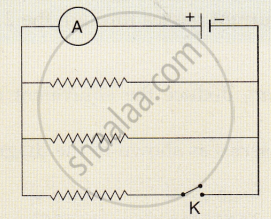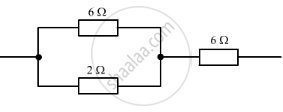Advertisements
Advertisements
Question
State the S.I. unit of electrical resistance and define it.
Solution
The S.I. unit of electrical resistance is ohm (Ω). The resistance of a conductor is said to be 1 ohm if 1 ampere current flows through it when the potential difference across its end is 1 volt.
APPEARS IN
RELATED QUESTIONS
Differentiate between resistances in series and parallel.
A hot plate of an electric oven connected to a 220 V line has two resistance coils A and B, each of 24 Ω resistances, which may be used separately, in series, or in parallel. What are the currents in the three cases?
In the diagram shown below, the cell and the ammeter both have negligible resistance. The resistor are identical.
The figure given below shows three resistors?

Their combined resistance is:
(a) `1 5/7`Ω
(b) `14` Ω
(c) `6 2/3` Ω
(d) `7 1/2` Ω
If current flows through two lamps arranged:
(a) in series,
(b) in parallel,
and the filament of one lamps breaks, what happens to the other lamp? Explain your answer.
State how are the two resistors joined with a battery when equivalent resistance is less than either of the two resistances.
Show how would you connect three resistors, each of resistance 6 O so that
the combination has a resistance of(a) 9 Ω (b) 4 .Ω
What are the advantages of a parallel connection?
How does the resistance of a metallic wire depend on the thickness of wire?
A coil in the heater consumes power P on passing current. If it is cut into halves and joined in parallel, it will consume power:
